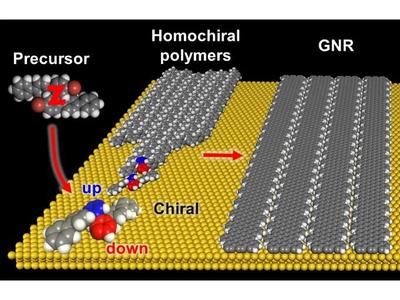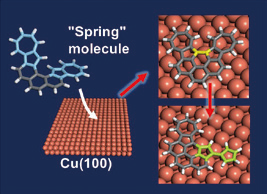Molecular Nanotechnology
Advanced Energy Utilization Division Molecular Nanotechnology Research Section
Professor : Hiroshi SAKAGUCHI
Assistant Professor : Takahiro KOJIMA, Shunpei NOBUSUE
Nanoscience and technology, ultimate method for producing new materials assembling from single molecules, are studied for energy sector such as organic transistors and solar cells.
http://molecule.iae.kyoto-u.ac.jp/
Nanoscience and technology using single molecules
Nanoscience and technology, ultimate techniques for producing new materials assembling from single molecules, are desired to apply in energy sector. Highly efficient devices such as field-effect transistors, solar cells, batteries could be realized by using nanotechnology. We have developed "Electrochemical Epitaxial Polymerization" technique which is a totally new molecular assembling technique of molecular wires on metal surface from single molecules using intense electric field at solid- solution interface (electric double layer). Also, "radical-polymerized chemical vapor deposition" technique which is totally new method to produce grapheme nanoribbons using high concentration of monomer radicals at interface between substrate and gas has been developed. Unprecedented molecular-wire materials consisting of carbon for energy usage will be developed by the use of these techniques. Polycyclic aromatic hydrocarbon molecules for a monomer of molecular wire and for molecular electronics will be synthesized using our new methodology. Organic electronic devices such as field effect transistors, photovoltaics, batteries and photocatalysis will be developed using our new techniques.
Conducting polymer wires array
Conducting polymer wires array on metal surface by the use of 'Electrochemical Epitaxial Polymerization' technique.

Bottom-up synthesis of graphene nanoribbons
Extremely narrow carbon wires developed by our bottom-up surface synthesis technique.
Bio-mimetic surface synthesis of graphene nanoribbons
GNRs can be produced by bio-mimetic principles consisting of chiral transformation, of designed z-bar-linkage precursors, self-assembly, homochiral polymerization and dehydorogenation.
Strain-induced skeleton rearrangement of hydrocarbon molecules on surface
Designed spring molecules on Cu surface can be transformed into the functional flvalene skeleton.











